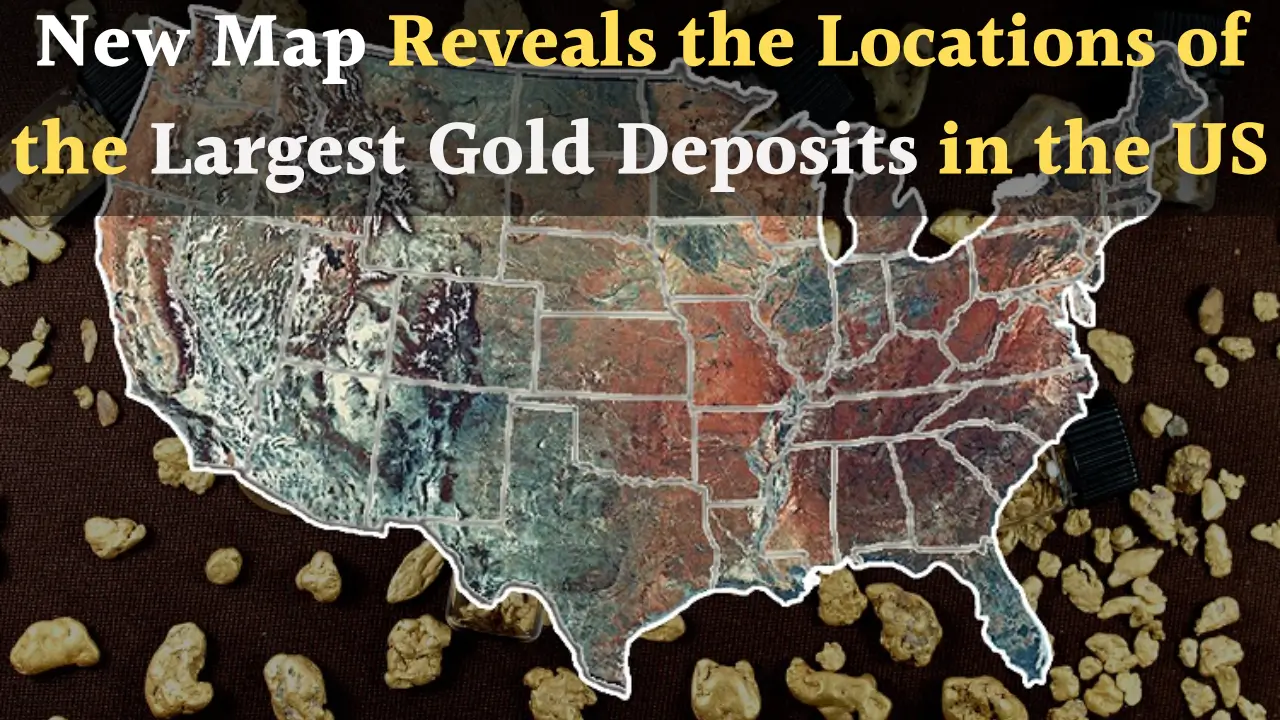The discovery of gold deposits has always played a decisive role in shaping the history and economy of the United States. From the California Gold Rush of 1848 to the modern mining operations in Nevada and Alaska, gold has remained both a symbol of prosperity and a vital component of economic development.
Recently, a new geological survey map has revealed the most significant gold deposits across the country, shining light on where vast reserves of the precious metal lie hidden beneath American soil.
This revelation is not merely a historical curiosity; it has direct implications for future mining investments, local economies, and the global gold market. By analysing the latest data, we can identify the regions where the largest gold reserves are concentrated and understand how America continues to play an essential role in gold production worldwide.
Understanding Gold in the US Economy
Gold remains one of the most valuable natural resources in the United States. Beyond jewellery and investment, it is used in medicine, electronics, aerospace engineering, and defence technologies. The US is consistently ranked among the world’s top producers of gold, with Nevada alone accounting for more than 75% of the nation’s output.
The discovery of massive deposits means greater opportunities for mining companies, increased job creation, and higher revenues for local governments through taxation and royalties. The unveiling of this new map has once again drawn attention to how certain regions of the US are blessed with some of the largest concentrations of gold in the world.
Key Gold-Bearing States in the US
Several states stand out as the primary contributors to America’s gold industry. The new map highlights the following as leading gold-rich regions:
- Nevada
- Alaska
- California
- Colorado
- South Dakota
Although Nevada dominates the gold sector, other regions also hold significant reserves that collectively strengthen the US as a global gold power.
Nevada: The Heart of US Gold
Nevada is often referred to as the “Silver State,” but when it comes to gold, it far outweighs every other state in the country. The Carlin Trend in northern Nevada, first discovered in the 1960s, is one of the world’s richest gold mining areas. Today, the Carlin and Cortez trends continue to produce millions of ounces annually.
Mining operations in Nevada are modern and extensive, employing advanced underground and open-pit techniques. The state has become the core of American gold mining, attracting both domestic and international investors.
Alaska: Remote but Resource-Rich
Alaska ranks second in the US for gold reserves. Its remote geography and harsh climate have not deterred large-scale mining operations, particularly around the Fort Knox mine in Fairbanks and the Kensington mine in Southeast Alaska.
Placer mining, a technique dating back to the Klondike era, still plays a role today, though on a smaller scale. Alaska’s rugged wilderness hides remarkable gold reserves that continue to draw miners despite logistical challenges.
California: The Original Gold Rush Land
California’s historic connection to gold traces back to Sutter’s Mill in 1848, the site that triggered the famous Gold Rush. While production levels today are modest compared to Nevada and Alaska, important operations still take place in northern California.
The Mother Lode belt and surrounding Sierra Nevada regions remain well known for their gold-bearing geological structures. California’s historical significance keeps it symbolically important in the American gold narrative.
Colorado and South Dakota: Historic yet Valuable
Colorado’s Cripple Creek & Victor mining district has long been recognised as a significant gold producer, while South Dakota’s Homestake Mine in Lead was once the largest and deepest gold mine in the Western Hemisphere.
Though Homestake ceased operations in 2001, remnants of its reserves continue to maintain South Dakota’s place on the gold map. Meanwhile, Colorado continues to produce gold on a commercial scale, albeit smaller than Nevada’s giants.
Table: Largest Gold Deposits in the United States
| State | Major Mining Areas/Deposits | Estimated Reserves (millions of ounces) | Notable Mines | Production Share in US (%) |
|---|---|---|---|---|
| Nevada | Carlin Trend, Cortez Trend, Twin Creeks | 120+ | Carlin, Cortez, Turquoise Ridge | ~75% |
| Alaska | Fort Knox, Pogo, Donlin Creek | 40+ | Fort Knox, Kensington, Pogo | ~12% |
| California | Mother Lode, Sierra Nevada | 10+ | Mesquite, Castle Mountain | ~3% |
| Colorado | Cripple Creek, Victor | 7+ | Cripple Creek & Victor Gold Mine | ~2% |
| South Dakota | Homestake (historic), Wharf Mine | 4+ | Wharf, Homestake (historic) | ~1% |
Why These Deposits Matter
The identification of such vast deposits through detailed maps is a critical milestone in America’s mining industry. These findings ensure long-term sustainability of gold mining and also encourage exploration activities in underexplored regions.
From a global perspective, the US gold reserves strengthen the dollar by enhancing investor confidence. Domestically, regions rich in gold deposits benefit from mining jobs, infrastructure growth, and revenue streams that support community development.
Modern Mining and Environmental Concerns
While mining continues to be a pillar of the economy, it does not come without environmental concerns. Issues such as water use, land disruption, and chemical waste, particularly from cyanide leaching, pose challenges for regulators and mining companies.
Modern US mining companies have begun adopting sustainable practices, including restoring mine lands, using safer chemicals, and reducing carbon footprints. The balance between economic benefit and environmental protection remains an ongoing debate.
Future of Gold Mining in the US
As the global demand for gold rises due to its role in investment portfolios and high-tech industries, the significance of US deposits will only grow. Nevada will remain the leader, but increasing exploration in Alaska and renewed interest in California could reshape production trends in the near future.
The importance of accurate geological mapping cannot be overstated. With new technologies like satellite imaging, AI-assisted exploration, and advanced drilling, the potential to discover even more hidden reserves in the US is substantial.
FAQs
Q1: Which state in the US has the largest gold deposits?
Nevada holds the largest deposits, producing more than 75% of all US gold.
Q2: Where was the first major US gold rush?
The California Gold Rush of 1848 at Sutter’s Mill marked the first major event.
Q3: What is the richest gold mining area in the US today?
The Carlin Trend in Nevada is considered the richest modern gold mining area.
Q4: Is gold mining still active in South Dakota?
Yes, though the Homestake Mine closed, the Wharf Mine continues small-scale production.
Q5: How does US gold production affect the global market?
US production strengthens supply, influences global pricing, and supports investor demand.
Conclusion
The new map revealing the locations of the largest gold deposits in the United States represents more than just a scientific discovery. It connects America’s past with its future, reminding us of the country’s historic relationship with gold while pointing towards ongoing economic opportunities. States like Nevada, Alaska, and California continue to anchor America’s position as a leader in global gold production. The combination of technological advancement, economic potential, and regional development makes gold a cornerstone of America’s natural resource wealth for decades to come.






